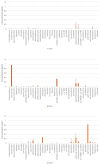Monitoring of Non-Maximum-Residue-Level Pesticides in Animal Feed: A Study from 2019 to 2023
- PMID: 39330608
- PMCID: PMC11435579
- DOI: 10.3390/toxics12090680
Monitoring of Non-Maximum-Residue-Level Pesticides in Animal Feed: A Study from 2019 to 2023
Abstract
Pesticides play a critical role in modern agriculture by protecting crops and ensuring higher yields, but their widespread use raises concerns about human health and environmental impact. Regulatory agencies impose Maximum Residue Levels (MRLs) to ensure safety, and the European Food Safety Authority (EFSA) assesses pesticide risks. This study monitored pesticide residues in 169 feed samples from Piedmont (Italy) collected between 2019 and 2023. Using GC-MS/MS, residues were found in 92% of animal-based and 70% of cereal-based feedstuffs. The most common pesticides in cereal-based feeds were pyrimiphos-methyl, deltamethrin, cypermethrin, azoxystrobin, and tetramethrin, and the pesticide synergist piperonyl-butoxide demonstrated a significant increase in contaminated samples in 2023. The lower concentrations in 2021 were likely due to COVID-19 impacts on pesticide availability. In animal-based feeds, common pesticides included deltamethrin, cypermethrin, and the pesticide synergist piperonyl-butoxide. The results highlight the pervasive presence of low-dose pesticide mixtures in feed and food chains, which could impact health, although do not pose acute risks. The study emphasizes the need for ongoing pesticide monitoring and awareness of the long-term effects of chronic pesticide exposure on animal, human, and environmental health.
Keywords: feed; maximum residue levels (MRLs); pesticides.
Conflict of interest statement
The authors declare no conflicts of interest.
Figures




References
-
- Chemical Safety: Pesticides. [(accessed on 31 July 2024)]. Available online: https://www.who.int/news-room/questions-and-answers/item/chemical-safety....
-
- Regolamento—396/2005—EN—EUR-Lex. [(accessed on 8 May 2024)]. Available online: https://eur-lex.europa.eu/legal-content/IT/TXT/?uri=CELEX%3A32005R0396.
Grants and funding
LinkOut - more resources
Full Text Sources
Miscellaneous

